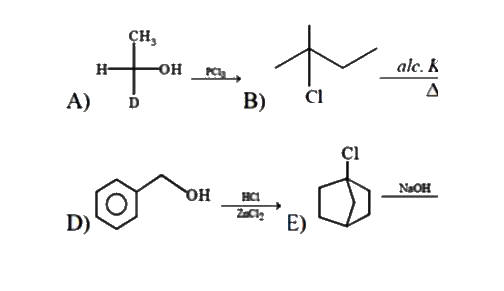Nucleophide substitution reaction is slowest with :
Iodolkanes
Fluoroalkanes
Chlorolkanes
Bromoalkanes
To determine which nucleophilic substitution reaction is slowest among iodoalkane, fluoroalkane, chloroalkane, and bromoalkane, we need to analyze the strength of the carbon-halogen bonds and their reactivity.
1. Identify the Halogen Bonds:
- In nucleophilic substitution reactions, the bond between carbon and the halogen (C-X bond) is broken. The halogens in question are fluorine (F), chlorine (Cl), bromine (Br), and iodine (I).
2. Understand Bond Strength:
- The strength of the C-X bond decreases as we move down the group in the periodic table. This means:
- C-F bond is the strongest.
- C-Cl bond is weaker than C-F.
- C-Br bond is weaker than C-Cl.
- C-I bond is the weakest among these.
3. Reactivity of Alkyl Halides:
- The reactivity of alkyl halides in nucleophilic substitution reactions generally increases as the bond strength decreases. Therefore, the order of reactivity is:
- Iodoalkane > Bromoalkane > Chloroalkane > Fluoroalkane.
4. Analyze Each Option:
- Iodoalkane: Weakest bond (most reactive).
- Bromoalkane: Weaker than chloroalkane but stronger than iodoalkane.
- Chloroalkane: Stronger bond than bromo and iodo, thus less reactive.
- Fluoroalkane: Strongest bond (least reactive).
5. Conclusion:
- Since fluoroalkane has the strongest C-F bond, it is the least reactive in nucleophilic substitution reactions. Therefore, the nucleophilic substitution reaction is slowest with fluoroalkane.
Final Answer:
The nucleophilic substitution reaction is slowest with Fluoroalkane.
---
- In nucleophilic substitution reactions, the bond between carbon and the halogen (C-X bond) is broken. The halogens in question are fluorine (F), chlorine (Cl), bromine (Br), and iodine (I).
- The strength of the C-X bond decreases as we move down the group in the periodic table. This means:
- C-F bond is the strongest.
- C-Cl bond is weaker than C-F.
- C-Br bond is weaker than C-Cl.
- C-I bond is the weakest among these.
- The reactivity of alkyl halides in nucleophilic substitution reactions generally increases as the bond strength decreases. Therefore, the order of reactivity is:
- Iodoalkane > Bromoalkane > Chloroalkane > Fluoroalkane.
- Iodoalkane: Weakest bond (most reactive).
- Bromoalkane: Weaker than chloroalkane but stronger than iodoalkane.
- Chloroalkane: Stronger bond than bromo and iodo, thus less reactive.
- Fluoroalkane: Strongest bond (least reactive).
- Since fluoroalkane has the strongest C-F bond, it is the least reactive in nucleophilic substitution reactions. Therefore, the nucleophilic substitution reaction is slowest with fluoroalkane.
The nucleophilic substitution reaction is slowest with Fluoroalkane.
Topper's Solved these Questions
- BOOK - ICSECHAPTER - SELF ASSESSMENT PAPER 7EXERCISE - Questions (Answer the following Questions)34videos
SELF ASSESSMENT PAPER 7
- BOOK - ICSECHAPTER - SELF ASSESSMENT PAPER 7EXERCISE - Questions (Answer the following Questions)34videos
SELF ASSESSMENT PAPER 7
- BOOK - ICSECHAPTER - SELF ASSESSMENT PAPER 1EXERCISE - QUESTIONS43videos
SELF ASSESSMENT PAPER 1
- BOOK - ICSECHAPTER - SELF ASSESSMENT PAPER-8EXERCISE - QUESTIONS11videos
SELF ASSESSMENT PAPER-8
Similar Questions
Knowledge Check
- Question 1 - Select One
Rate of substitution reaction in phenol is :
Aslower than the rate of benzeneBfaster than the rate of benzeneCequal to the rate of benzeneDnone of these - Question 2 - Select One
The ether that undergoes electrophilic substitution reactions is
ACH3OC2H5BC6H5OCH3CCHOCH3DC2HOC2H3 - Question 3 - Select One
Which one is a nucleophilic substitution reaction among the following ?
ARCHO+R'Mgx→R−C∣OHH−RBCH3−CH2−oevrset(CH3)∣CH−CH2Br+NH3→CH3−CH2−CH3∣CH−CH2NH2CCH3CHO+HCN→CH3CH(OH)CNDCH3−CH=CH2+H2OH+−−→CH3−C∣OHH−CH3
Explain why nucleophilic substitution reactions are not very common in phenols ?
View SolutionExplain why nucleophilic substitution reactions rae not very common in phenols.
View SolutionNucleophilic substitution reaction of optically active halide, PIC is accompanied by
View SolutionWhat are nucleophilic substitution reactions ? Give an example.
View SolutionIn electrophilic substitution reactions of haloarenes, halogen atom is
View Solution


